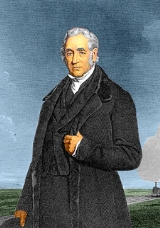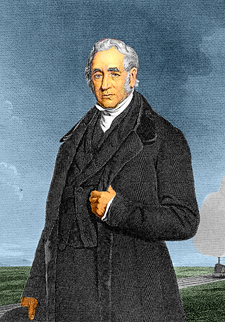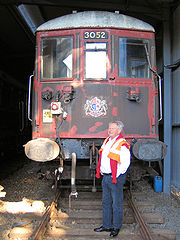
Transport Trust
Encyclopedia

Almost every part of Britain has been touched by the then white heat of technology, whether as part of the Industrial Revolution or in a more recent era. Yet, strangely, despite Britain's rich and globally important successes, no one has ever constructed a comprehensive log to commemorate great engineers, pathfinding operating companies, the visions of Roman military strategists and the teams that took us further, faster, cheaper. Linking each Red Wheel plaque to the Our Transport Heritage website should encourage not only greater understanding of the site’s history and context, but also promotes physical engagement - satellite images and location maps, routing information, website and contact details, opening hours and even local weather forecasts are provided to make it easy for the public to visit each location.
To help the public better understand timelines and context, website visitors can cross-search by county, by transport category (road, rail, air and water) and by constructer/engineer/architect. This joined-up approach should encourage widespread use of the site by schools, tourist boards and local authorities. Just as transport links brought economic prosperity to towns and villages, the internet now links locations to educate, inform and enthuse the British population.
Pressures on heritage preservation
The Heritage Lottery FundHeritage Lottery Fund
The Heritage Lottery Fund is a fund established in the United Kingdom under the National Lottery etc. Act 1993. The Fund opened for applications in 1994. It uses money raised through the National Lottery to transform and sustain the UK’s heritage...
commissioned the Transport Trust to assess pressures on the transport heritage movement, and the state of artefacts and locations to help them prioritise applications for funding support. The resulting 145 page report, Transport Heritage: An Assessment of Needs & Potential', provides a unique snapshot of the health of the transport preservation movement in Britain. The movement is important, touching people at many levels and has a wide appeal - it is estimated that audiences and participants in heritage transport activities exceed 15 million people a year, making it one of Britain's most important leisure activities. Britain's particularly rich transport history has no doubt played a catalytic role to build up this level of grass roots participation.
Surprisingly, although there are good collections of artefacts in public sector museums, it is the private sector preservationists that have made the most significant contribution to conservation and to the provision of the active enjoyment of transport by the public. A supreme example is the restoration to flight status of Avro Vulcan XH558
Avro Vulcan XH558
Avro Vulcan XH558 The Spirit Of Great Britain is the only airworthy example of the 134 Avro Vulcan V-bombers that were operated by the Royal Air Force from 1953 until 1984. Vulcan XH558 served with the RAF between 1960 and 1985 in the bomber, maritime reconnaissance and air-to-air refuelling roles...
, which represents the most complex restoration project ever undertaken globally, was funded entirely by public donations and for which the Chief Executive of the Vulcan To The Sky Trust
Vulcan To The Sky Trust
Vulcan to the Sky Trust is a British charity that owns and operates Vulcan XH558 a former Royal Air Force Avro Vulcan V-bomber from Bruntingthorpe Aerodrome....
, Dr Robert Pleming, was presented the Transport Trust Preservationist of The Year award by Prince Michael of Kent
Prince Michael of Kent
Prince Michael of Kent is a grandson of King George V and Queen Mary, making him a cousin of Queen Elizabeth II. He is also the first cousin once removed of Prince Phillip. Prince Michael occasionally carries out royal duties representing the Queen at some functions in Commonwealth realms outside...
.
The key conclusions for each major transport area are:
Aviation
The widespread preservation of aircraft in the UK began in the 1960s when a large number of obsolete military aircraft became available. A push to co-ordinate the movement led to founding of the British Aviation Preservation Councilhttp://www.bapc.org.uk/ (BAPC) in 1967, but very few private collections are represented. Although over 2,500 aircraft survive and are capable of preservation, little progress has been made to develop a clear preservation strategy, with 4% of the highest graded and as many as 26 % of the second kept outside. Historically, insufficient attention has also been paid to preserving airfield architecture, although the designation in 2007 of Duxford Aerodrome as a Conservation AreaConservation area
A conservation areas is a tract of land that has been awarded protected status in order to ensure that natural features, cultural heritage or biota are safeguarded...
will help preserve a virtually intact site, first established as a Royal Flying Corps base in 1916 and fully operational as an RAF base until 1961. This Battle of Britain
Battle of Britain
The Battle of Britain is the name given to the World War II air campaign waged by the German Air Force against the United Kingdom during the summer and autumn of 1940...
airfield, home to Douglas Bader
Douglas Bader
Group Captain Sir Douglas Robert Steuart Bader CBE, DSO & Bar, DFC & Bar, FRAeS, DL was a Royal Air Force fighter ace during the Second World War. He was credited with 20 aerial victories, four shared victories, six probables, one shared probable and 11 enemy aircraft damaged.Bader joined the...
's Big Wing
Big Wing
The Big Wing, also known as a Balbo, was an air fighting tactic proposed during the Battle of Britain by 12 Group commander Air Vice-Marshal Trafford Leigh-Mallory and Acting Squadron Leader Douglas Bader. In essence, the tactic involved meeting incoming Luftwaffe bombing raids in strength with a...
experiments and the first RAF base to receive the Supermarine Spitfire
Supermarine Spitfire
The Supermarine Spitfire is a British single-seat fighter aircraft that was used by the Royal Air Force and many other Allied countries throughout the Second World War. The Spitfire continued to be used as a front line fighter and in secondary roles into the 1950s...
, now houses the Imperial War Museum Duxford
Imperial War Museum Duxford
Imperial War Museum Duxford is a branch of the Imperial War Museum near the village of Duxford in Cambridgeshire, England. Britain's largest aviation museum, Duxford houses the museum's large exhibits, including nearly 200 aircraft, military vehicles, artillery and minor naval vessels in seven...
http://duxford.iwm.org.uk/, the largest centre of European aviation history and home to the largest collection of American aircraft outside of the US.
The key needs for the aviation category are to prioritise individual aircraft for preservation; to move middle grade airframes into hangarage; to pay greater attention to civil aircraft; to deal with pressing gaps in conservation skills and to consider grounding benchmark airframes.
Buses and coaches
There are about 4,000 buses and coaches in preservation of which some 45% are in a recognised collection or museum, private or public, but less than 30% are restored. Most in museums are from the 1950s and 1960s, with only 10% from before 1940, butover 80% of the total are owned by private individuals - with little support they have been responsible for the majority of bus conservation. Little progress has been made in prioritising this assortment, which is scattered all over the country, with someconcentration in the cities.
The key needs for the bus and coach category are the completion of a category register of preserved buses as a prelude to
introducing a grading system; a strategy for accommodating at least the most important vehicles under cover (presently 50% of all preserved buses are stored in the open); the conservation of the most important vehicles; facilities for improved public access and education; an archive of papers, ephemera and small artefacts which might otherwise disappear.
Railways

Heritage Railway Association
The Heritage Railways Association is an umbrella organisation representing the majority of the heritage and tourist railways, railway museums, steam centres and railway preservation groups in the UK and Ireland....
provides support and advice to heritage lines. The busiest heritage line in Britain is the North York Moors Railwayhttp://nymr.co.uk/, which operates over 100 days a year over the bulk of the 24 mile trackbed constructed by George Stephenson
George Stephenson
George Stephenson was an English civil engineer and mechanical engineer who built the first public railway line in the world to use steam locomotives...
and which opened in 1836.
The key needs for the railways category are a grading system for vehicles and lines to focus funding on the most worthy; safe access for the public to workshops and sheds to increase visitor appeal; covered accommodation for both restoration work and carriage storage; a concerted effort to conserve electric trains; support for private enthusiast restoration projects to increase capacity; archive storage to minimise losses of priceless records.
Maritime
This diverse and scattered category is highly dependent on private individuals. Only canal and inland waterways craft have a degree of structure, largely because of their links with the waterways. Others such as fishing boats, lifeboats and traditional river craft are found all round the UK. In museums smaller vessels are typically overshadowed by larger ones. Steam has a strong following. Most boats are privately owned and the majority are sailable. There are probably about 500 small boats of major historical importance which should be preserved - their interests are managed by a plethora of ‘umbrella’ organisations, to which the National Maritime MuseumNational Maritime Museum
The National Maritime Museum in Greenwich, England is the leading maritime museum of the United Kingdom and may be the largest museum of its kind in the world. The historic buildings forming part of the Maritime Greenwich World Heritage Site, it also incorporates the Royal Observatory, Greenwich,...
http://www.nmm.ac.uk/ is attempting to bring a degree of co-ordination. The National Small Boat Register, managed by the National Maritime Museum Cornwall
National Maritime Museum Cornwall
The National Maritime Museum Cornwall is located in a harbourside building at Falmouth in Cornwall. The building was designed by architect M. J...
http://www.nmmc.co.uk, maintains listings of over 1,200 small craft (under 12m/40 ft) that embrace rarity, historic and cultural value. The Advisory Committee for National Historic Ships maintains a register of larger historic vessels [over 10.1m/33 ft] that have demonstrably strong UK associations.
The key needs for the maritime category are a common grading system across the category is needed in order to prioritise
conservation efforts; the preservation of the 500 small craft of significant heritage importance could be enhanced by relatively modest supporting sums; more training in traditional skills; safe storage where boats at risk could be placed pending restoration.
General conclusions
Despite the rich diversity of Britain's transport heritage, there are many common threads. The most important is that much of our heritage is at risk. Prioritisation must be positively encouraged, and its coordination funded; better to save the best than lose the majority over time. Strategic leadership and vision is vital and umbrella organisations can play a vital role. Undercover storage is also critical for artifacts that have long exceeded their envisaged working lives. And, finally, since transport is appreciated most when used, many irreplaceable historical relics are wearing out and should be replaced by working replicas.The Trust's objectives

Brighton Belle
The Brighton Belle was a named train which ran on the Southern Railway from Victoria Station in London to Brighton, on the Sussex coast. The first electric all-Pullman service in the world, it ran from 29 June 1934 till 30 April 1972.-History:...
- this named Pullman train ran on the Southern Railway from London to Brighton from 1934 until its unpopular withdrawal in April 1972. The Brighton Belle was the first electric all-Pullman service in the world; certainly the best-known electric train in the UK.
The Trust's Vice President, Sir Jack Hayward, made possible the salvage operation of the SS Great Britain
SS Great Britain
SS Great Britain was an advanced passenger steamship designed by Isambard Kingdom Brunel for the Great Western Steamship Company's transatlantic service between Bristol and New York. While other ships had previously been built of iron or equipped with a screw propeller, Great Britain was the first...
from the Falkland Islands
Falkland Islands
The Falkland Islands are an archipelago in the South Atlantic Ocean, located about from the coast of mainland South America. The archipelago consists of East Falkland, West Falkland and 776 lesser islands. The capital, Stanley, is on East Falkland...
, and the return to flight status of Avro Vulcan XH558
Avro Vulcan XH558
Avro Vulcan XH558 The Spirit Of Great Britain is the only airworthy example of the 134 Avro Vulcan V-bombers that were operated by the Royal Air Force from 1953 until 1984. Vulcan XH558 served with the RAF between 1960 and 1985 in the bomber, maritime reconnaissance and air-to-air refuelling roles...
, through extremely large donations, and is currently a major donor to the restoration of an Airspeed Horsa
Airspeed Horsa
The Airspeed AS.51 Horsa was a British World War II troop-carrying glider built by Airspeed Limited and subcontractors and used for air assault by British and Allied armed forces...
glider and a Douglas C-47 Skytrain
C-47 Skytrain
The Douglas C-47 Skytrain or Dakota is a military transport aircraft that was developed from the Douglas DC-3 airliner. It was used extensively by the Allies during World War II and remained in front line operations through the 1950s with a few remaining in operation to this day.-Design and...
as lasting memorials to British airborne forces.
The Trust also offers legal and technical advice to conservation groups and bodies such as Heritage Link, the Heritage Lottery Fund
Heritage Lottery Fund
The Heritage Lottery Fund is a fund established in the United Kingdom under the National Lottery etc. Act 1993. The Fund opened for applications in 1994. It uses money raised through the National Lottery to transform and sustain the UK’s heritage...
and the UK Government. It presents annual restoration awards and has a particular mission to encourage young people to take part in restoration projects. The Trust's Patron is Prince Michael of Kent
Prince Michael of Kent
Prince Michael of Kent is a grandson of King George V and Queen Mary, making him a cousin of Queen Elizabeth II. He is also the first cousin once removed of Prince Phillip. Prince Michael occasionally carries out royal duties representing the Queen at some functions in Commonwealth realms outside...
.

